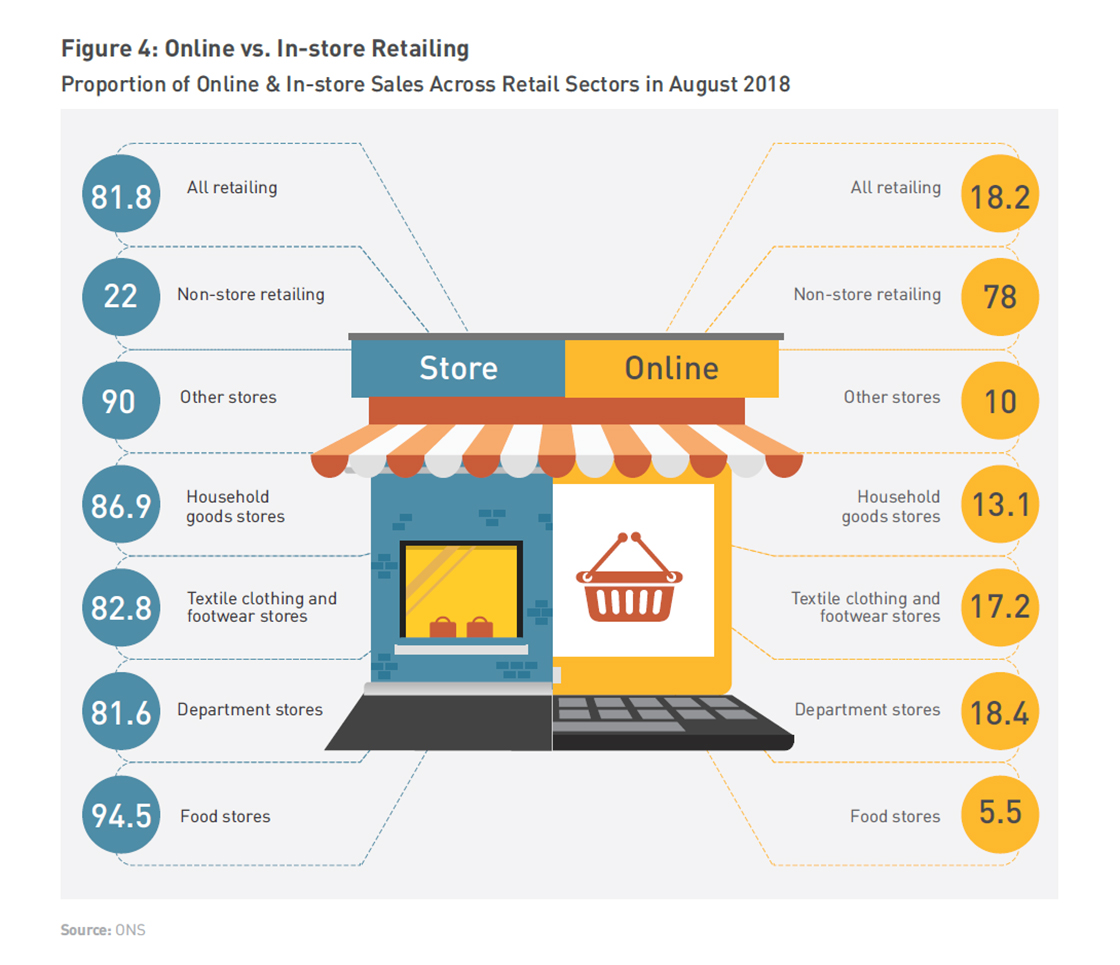Overview
U.K.'s retail industry is coping with
the same challenges from ecommerce
disruption as the rest of
the world. The industry is also
facing ambiguity due to the political
situation and Brexit. Collectively,
this has caused a momentary
slowdown in the industry.
The sharp rise in the number of
store closures between the first
half of 2017 and 2018 alongside
record online sales in August 2018
points at the growing significance
of online stores. The category of
clothing and department is
witnessing more growth online as
compared to food, with growth trend of the latter remaining flat in
the last four years. While U.K.
shoppers are gravitating towards
online shopping for items such as
clothes and shoes, they seem to
still prefer the traditional way of
shopping for food.
The uncertainty around Brexit
has led to retailers grappling with
questions about the future and
customers showing patterns of
conservative spend. The retail
sector Gross-Value Added (GVA)
declined in the month following
the Brexit referendum. While the
sector recovered, growth has
been flat in 2018, with customers being cautious even during
peak shopping periods such as
Black Friday.
2019 is expected to witness a slow
growth, given the six-month delay
in Brexit, continued ambiguity in
the political situation, rising costs
of import and supply chain
pressures. However, once the new
trade framework is defined and
stabilized, a faster pace of growth
can be expected between 2020
and 2023.
WNS DecisionPointTM deep dives
into trends in the U.K. retail sector,
and explores the factors impacting
growth and future outlook.
INTRODUCTION
Retail Sector and the U.K. Economy
The retail sector is an essential
backbone of the U.K. economy. With
a total contribution of GBP 91.6
Billion to the total U.K. GDP in 2017,
it accounts for over 5 percent of the U.K. economy.1 The retail sector has
gone through a prolonged period of
disruption. Shifting consumer
behavior, increase in online stores,
and shopping and uncertainty in economic outlook brought on by
Brexit are some of the key factors
impacting the way retailers deal
with consumers and plan their
business strategies for the future.
We assess the current swings in the
retail sector and forecast the course
of the sector in the wake of current
political and Brexit developments.
The retail sector fell into a slump
following the financial crisis of 2008,
and continued to witness a steep
decline until 2012. The sector
started to recover in 2013 and
continued to grow stronger until
late 2016. However, 2017 and 2018
witnessed a slight slowdown in
sector output (see Figure 1).
The retail sector GVA experienced a
steep drop in the month following
the Brexit referendum, but soon
picked up pace from October 2016 onwards. The decline can be
attributed to an uncertain outlook
perceived by businesses in the aftermath of U.K.'s surprise
decision to leave the European
Union (EU).
Retail sales in the latter half of 2018,
specifically December, were flat in
volume terms, as shown by the three-month rolling average index
(Figure 2). Consumers refraining
from further spending after Black Friday promotions and the U.K.'s
looming exit from the EU were
primarily accountable for the decline.


Online Shopping: A Rising Challenge for Retailers
One of the key concerns plaguing
retailers is the continued growth of online shopping, with market
turbulence across the industry creating ideal conditions for new
entrants to flourish (Figure 3).


Online sales were approximately
18 percent of all retailing in the
U.K., accompanied by strong growth in clothing and department
stores. Department stores, in
particular, saw record online sales of 18.4 percent in August
2018 (Figure 4).
Online sales in food stores grew at
a strong pace from February 2018
to May 2018, but were witness to a
slowdown in growth, with sales at
5.5 percent in August 2018.
An assessment of the 10-year
growth in online sales shows
significant increase across the non-specialized and clothing store
categories, but a much slower pace
of increase in the food store
category, with online sales
remaining relatively flat in the last
four years. This trend reflects
consumers' growing preference for
purchasing majority of clothing and
footwear items online, while at the same time sticking to more
conventional modes of shopping in
the food store category.
The resulting impact of the
increasing popularity of online
retailing is perhaps best reflected in
the number of physical store closures
in the U.K. in the last five years.
The number of store closures rose
drastically, from approximately
20,000 in the first half of 2017 to over 24,000 in the first half of 2018
(Figure 6). Burgeoning
occupational costs and rising competition forced many retailers
to announce a slowdown in store
openings.
The High Street: Preparing for Turbulence
The year 2017 was a tough one for
high-street retailers as they were
up against rising import costs resulting from a falling pound.
A surge in employment costs and
escalating investment in technology upgradation and store
experience further eroded retailer
margins (Figure 7).
Many retailers had hoped for an
improved outlook in 2018. However,
freezing temperatures led to a
slowdown in high-street sales in the first quarter of the year. In the
wake of the royal wedding and the
World Cup fever, the middle of the
year did witness a slight uptick, steered primarily by increased
spending on food and
entertainment.
Homeware sales on the high street
recovered significantly towards the
end of the year, after experiencing a major slowdown during the middle
of the year (Figure 8). Non-store
sales witnessed several upheavals throughout the year, reflecting the
volatility in consumer spending and
sinking consumer confidence.
Retail Outlook: Five-year Scenario
The U.K. retail industry will
continue to battle headwinds in
the form of low consumer and business confidence brought
on by the current Brexit
turmoil, disruptive technological trends and volatile consumer
expectations.
With the six-month Brexit delay, we
expect retail sales to rise at a slow
pace for the rest of 2019 (Figure 8).
Continued political uncertainty and
supply chain pressures will result in increased import costs for
retailers and rising cost pressures
for end consumers. Retail sales are
expected to pick up faster from
2021 to 2023, as trade pressures on the U.K. recede with a definite
trading framework with the rest of
the world in place.